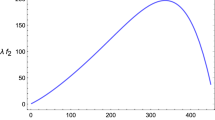Abstract
We revisit the variable \(\Lambda\) theory recently developed by Alexander et al. [1, 2]. We implement it to explain the current expansion of the Universe. The varying \(\Lambda\) theory reduces one degree of freedom. The varying \(\Lambda\) term (cosmological term) follows the energy density of the Universe. We consider such a theory which does not respect self-dual symmetry. The Bianchi identity enforces the \(\Lambda\) term to be a constant for a theory without torsion. However, torsion can incorporate a varying \(\Lambda\) term in the action. We consider a form of the action which has such a varying \(\Lambda\) term, and the presence of only nonrelativistic matter energy density. We fit the luminosity distance according to the model and compare it with that in the \(\Lambda\textrm{{CDM}}\) model and find their close behavior. However, we find a current value of matter energy density \(\rho_{m0}\) larger than the critical energy density. Using the supernova data from Union 2.1 compilation, we further consider a different set of parameters, for which \({\kappa\rho_{m0}}/{3H_{0}^{2}}\) becomes close to unity but, however, greater. For this set of parameters, we find a negative value in the effective equation of state, however, the model has a very different pattern of the Hubble parameter from the standard scenario.




Similar content being viewed by others
REFERENCES
S. Alexander, M. Cortцks, A. R. Liddle, J. Magueijo, R. Sims, and L. Smolin, “The cosmology of minimal varying Lambda theories,” Phys. Rev. D 100, 083507 (2019).
S. Alexander, M. Cortцks, A. R. Liddle, J. Magueijo, R. Sims, and L. Smolin, “A zero-parameter extension of general relativity with varying cosmological constant,” Phys. Rev. D 100, 083506 (2019).
S. Weinberg, “The Cosmological Constant Problem,” Rev. Mod. Phys. 61, 1 (1989).
J. D. Barrow and F. J. Tipler, The Anthropic Cosmological Principle (Oxford University Press, 1988).
P. C. W. Davies, “The anthropic principle,” Prog. Part. Nucl. Phys. 10, 1 (1983).
J. J. van der Bij, H. van Dam and Y. J. Ng, “The exchange of massless spin two particles,” Physica 116A, 307 (1982).
W. Buchmuller and N. Dragon, “Einstein gravity from restricted coordinate invariance,” Phys. Lett. B 207, 292 (1988).
S. W. Hawking, “The cosmological constant is probably zero,” Phys. Lett. B 134, 403 (1984).
S. R. Coleman, “Why there is nothing rather than something: a theory of the cosmological constant,” Nucl. Phys. B 310, 643 (1988).
S. R. Coleman and F. De Luccia, “Gravitational effects on and of vacuum decay,” Phys. Rev. D 21, 3305 (1980).
S. Weinberg, “Does gravitation resolve the ambiguity among supersymmetry vacua?,” Phys. Rev. Lett. 48, 1776 (1982).
D. Friedan, E. J. Martinec, and S. H. Shenker, “Conformal invariance, supersymmetry and string theory,” Nucl. Phys. B 271, 93 (1986).
M. Dine and N. Seiberg, “Nonrenormalization theorems in superstring theory,” Phys. Rev. Lett. 57, 2625 (1986).
A. Morozov and A. Perelomov, “Statistical sums in superstring theory. Genus 2,” Phys. Lett. B 199, 209 (1987).
A. K. Yadav and A. Sharma, “A transitioning universe with time-varying \(G\) and decaying \(\Lambda\),” Res. Astron. Astrophys. 13, 501–508 (2013).
G. Papagiannopoulos, P. Tsiapi, S. Basilakos and A. Paliathanasis, “Dynamics and cosmological evolution in \(\Lambda\)-varying cosmology,” Eur. Phys. J. C 80, 55 (2020).
C. Chawla, R. K. Mishra, and A. Pradhan, “String cosmological models from early deceleration to current acceleration phase with varying \(G\) and Lambda,” Eur. Phys. J. Plus 127, 137 (2012).
J. P. Singh and R. K. Tiwari, “Perfect fluid Bianchi Type-I cosmological models with time varying \(G\) and Lambda,” Pramana 70, 565–574 (2008).
G. K. Goswami, M. Mishra, A. K. Yadav, and A. Pradhan, “Two fluid scenario in Bianchi Type-I universe,” Mod. Phys. Lett. A 35, 2050086 (2020).
G. K. Goswami, A. K. Yadav, and R. N. Dewangan, “Magnetised strings in \(\Lambda\)-dominated anisotropic Universe,” Int. J. Theor. Phys. 55, 4651–4664 (2016).
A. K. Yadav, “A transitioning universe with anisotropic dark energy,” Astrophys. Space Sci. 361, 276 (2016).
G. K. Goswami, R. N. Dewangan, and A. K. Yadav, “\(\Lambda\)CDM type Heckmann-Schuking model and Union 2.1 compilation,” Grav. Cosmol. 22, 388–393 (2016).
G. K. Goswami, A. K. Yadav and M. Mishra, “\(\Lambda\)CDM-type cosmological model and observational constraints,” Int. J. Theor. Phys. 54, 315-325 (2015).
D. M. Scolnic, et al., “The Complete light-curve sample of spectroscopically confirmed Sne Ia from Pan-STARRS1 and cosmological constraints from the combined Pantheon sample,” Astrophys. J. 859, 101 (2018).
A. K. Camlibel, I. Semiz, and M. A. Feyizoglu, “Pantheon update on a model-independent analysis of cosmological supernova data,” arXiv: 2001.04408.
D. L. Miller and D. Branch, “Supernova absolute-magnitude distributions,” Astron. J. 100, 530–539 (1990).
Author information
Authors and Affiliations
Corresponding authors
Rights and permissions
About this article
Cite this article
Fang, Y., Singh, N.K. Varying \(\boldsymbol{\Lambda}\) Theory Revisited. Gravit. Cosmol. 27, 47–53 (2021). https://doi.org/10.1134/S0202289321010084
Received:
Revised:
Accepted:
Published:
Issue Date:
DOI: https://doi.org/10.1134/S0202289321010084




